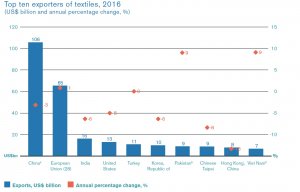
World textile and apparel exports fall in 2016
Exports to EU countries from many of the world’s leading clothing exporting countries fell at rapid rates in 2012, reflecting continuing uncertain economic conditions in the region, according to a new report from the global business information company Textiles Intelligence – Trade and trade policy: the world’s leading clothing exporters and key markets. Exports to countries in the Middle East, by contrast, grew strongly – as did exports to a number of countries in Asia and South America.

19th September 2013
Knitting Industry
|
UK
Exports to EU countries from many of the world’s leading clothing exporting countries fell at rapid rates in 2012, reflecting continuing uncertain economic conditions in the region, according to a new report from the global business information company Textiles Intelligence – Trade and trade policy: the world’s leading clothing exporters and key markets.
Exports to countries in the Middle East, by contrast, grew strongly – as did exports to a number of countries in Asia and South America.
Exporting to EU countries was difficult also for EU exporters themselves. So, whereas EU exports to countries outside the EU increased by 12.1%, exports from EU member states to other countries within the EU declined by 11.6%.
For clothing manufacturers based in China, exports to Germany fell by a sharp 22.4% and exports to France fell by 14.0%. In fact, Germany and France were the only two countries among China’s ten largest markets to which exports declined. Moreover, Italy, Spain and the Netherlands no longer ranked among China’s ten largest markets, even though in 2011 they were, respectively, China’s eighth, ninth and tenth biggest markets.
China’s exports to Vietnam, by contrast, surged by 115.1%, exports to the UAE rose by 25.3% and exports to Russia went up by 14.0%.
One country which did manage to increase its exports to a number of EU countries was Turkey. However, Turkish exports to non-EU countries grew more strongly.
For clothing manufacturers based in Vietnam, the fastest growth among the country’s ten largest markets was in exports to China (up by 33.0%), followed by those to South Korea (up by 32.3%) and Japan (up by 18.4%). In fact, China is expected to overtake the USA to become Vietnam’s largest trading partner by 2030.
Exports from Vietnam to other Asian countries are also forecast to grow significantly over the coming years, and exports from Vietnam to the whole of Asia (excluding Japan) are expected to rise by an average of 15% per annum between 2013 and 2020.
For manufacturers based in India, exports to eight of the country’s ten largest markets declined in 2012.
In particular, there were sharp declines in Indian exports to a number of EU countries, including Belgium (down by 24.7%), Italy (down by 23.6%), Germany (down by 22.2%), France (down by 21.8%) and the Netherlands (down by 15.9%).
The only increases were in Indian exports to the UAE (up by 9.6%) and Saudi Arabia (up by 3.7%).
Manufacturers in Indonesia also suffered sharp declines in their exports to a number of EU countries, including the Netherlands (down by 24.8%), France (down by 23.1%) and Germany (down by 13.0%).
By contrast, Indonesian exports to Japan rose by 42.6%, those to South Korea were up by 35.7% and those to the UAE increased by 15.4%.
For manufacturers in Malaysia, meanwhile, the fastest increase was in exports to Brazil (up by 20.4%) while the steepest declines were in exports to the UK (down by 14.9%), Italy (down by 11.8%), Belgium (down by 11.1%), Germany (down by 3.5%) and France (down by 2.8%).
Looking ahead, emerging economies will continue to provide exporters with growth opportunities. Also, the situation in the EU, and in the eurozone in particular, is expected to improve after the latter region officially climbed out of recession in the second quarter of 2013, following 18 months of contraction.
However, any growth in the EU economy in 2013 will be slow, and global trade growth – although up on the previous year – will continue to be much slower than in the years prior to the global economic crisis.
Furthermore, while this weakness persists, the threat of protectionism could build and have a negative impact on global trade – especially given the fact that other attempts to restore growth following the global economic crisis have failed.
‘Trade and trade policy: the world’s leading clothing exporters and key markets’ was published by the global business information company Textiles Intelligence and can be purchased by following the link below:
Trade and trade policy: the world’s leading clothing exporters and key markets
Other recently published reports from Textiles Intelligence include:
Global apparel markets – product developments and innovations (Q2 2013)

Business intelligence for the fibre, textiles and apparel industries: technologies, innovations, markets, investments, trade policy, sourcing, strategy...
Find out more